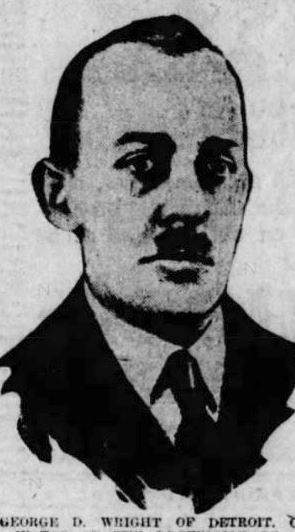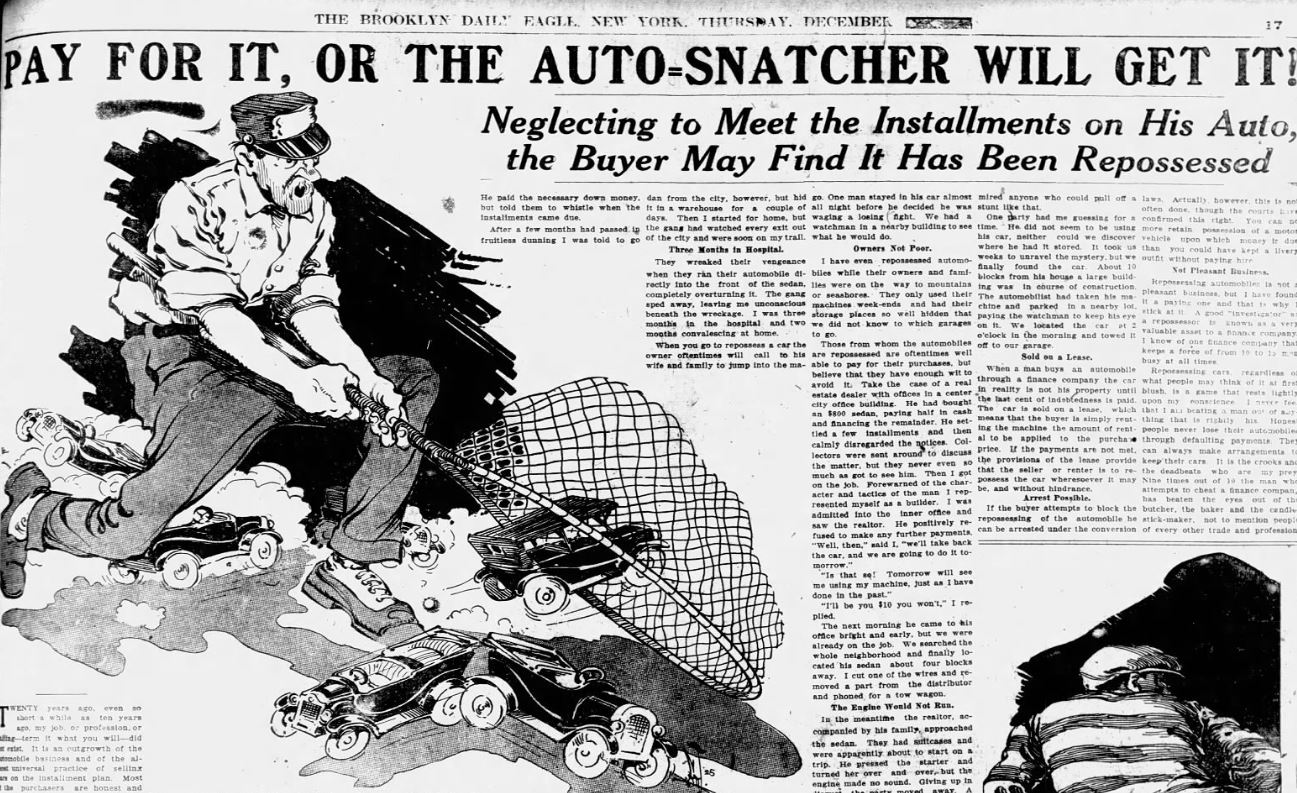“AUTO SNATCHING” 1925 – AN EARLY ADJUSTERS ACCOUNT
I thought I was done with the research for Repo Blood – A Century of Auto Repossession History, when I stumbled across something I never thought could be found. The identity and face of the first professional repossession agent, or “Auto-Snatcher” as they were sometimes referred to back then. Now that free previews of the book are available in e-book format on Amazon Kindle and Barnes & Noble’s Nook, I guess it’s safe to let the cat out of the bag.
“AUTO SNATCHING” 1925 – AN EARLY ADJUSTERS ACCOUNT
The earliest written account of life as a repossession agent, referred to as an “Auto-Snatcher” in a December 10, 1925, story in the Brooklyn Daily Eagle. According to the article, the agent states that the profession did not exist as recent as ten years ago and that it is an outgrowth of the installment loan plan. He describes the majority of borrowers being honest and prompt paying but describes the need for his services when “a certain class of thieves and deadbeats attempt to beat the finance companies. That’s where I come in, when a man has fallen down on his installments and we are satisfied that he is trying to gyp us, I go out and repossess the car.
Odd enough, he refers to his profession in the “Auto-Snatching” term which had been a term long used for auto thieves and also often refers to the cars as “machines.” Throughout the lengthy article, he describes repossessing cars chained to trees, placed on elevators, disabled, and hidden between floors or on upper floors of buildings. His experiences resonate a big city feel as he discusses having been in numerous fights and having been shot four times. As has become a custom of such articles, he boasts of his immediate return to work from injury without losing a step.
This was the “Roaring Twenties” and the mob and prohibition were in full swing. It comes natural that he would share his tale of his encounter with a “Notorious Gang” of seven brothers “three of whom have gone to the chair” who “have stolen millions of dollars of goods and are still feared by police and civilians alike.” His story goes on to reveal his successful repossession of a vehicle that he had to hide in the city as the gang watched out for it at every exit from the city.
Finally attempting to get it out of town, he reports that the gang “ran their vehicle directly into the front of the sedan, overturning it. The gang sped away leaving me unconscious beneath the wreckage. I was three months in the hospital and two months convalescing at home.” An entertaining story, but odd they didn’t get out and kill him, if you ask me.
While speaking lightly of recovery tactics, he mentions using a “tow machine” or “tow wagon” as he refers to it, but never speaks of hot-wiring, breaking in or picking locks. Blocking in and disabling vehicles appear to be primary methods of recovery employed by this agent at least. Interesting enough though, he does discuss the use of law enforcement under conversion laws of the time. Regardless, he does caveat this stating that “this is not often done, though the courts have confirmed this right.”

In closing the article, he claims that “A good investigator, or a repossessor is known as a very valuable asset to a finance company. I know of one finance company that keeps a force from 10 to 15 men busy at all times.”
His perspective on borrowers is interesting in that he seems to draw an extremely hard line between two types. “Honest people never lose their automobiles through defaulting payments. They can always make arrangements to keep their cars. It is the crooks and deadbeats who are my prey. Nine times out of ten, it is the man who attempts to cheat the finance company that has beaten the eyes out of the butcher, the baker and the candlestick maker.”
He doesn’t speak of commissions or being part of any detective agency or adjustment bureau and appears to be a “lone wolf” repossessor, which was more common in this era. Articles like these, which have been a constant in the industry, can be difficult to judge for credibility. Regardless, they do offer an intriguing glimpse into the repossession industry during specific periods.
Weeks later, on December 24th, in a different article titled “Car Snatching” a New Art, Detroit News writer E.J. Beck interviewed a man with an identical story. The man interviewed was George D. Wright of Detroit. This places Detroit as the cradle of professional repossessions and George D. Wright as probably the first of this profession. Wright’s motto was “Don’t fight-em, fool ‘em.”
###
While we can’t be 100% certain of George D. Wright’s claims or stories, this does represent the name and tales of the earliest known repossession agent at this point in time. I attempted to find out more about him but came up with nothing.
Please come read the first two chapters in the kindle or nook previews. Honestly, these two chapters are the slowest of the book, but are still very informative and set the stage for some far more interesting accounts.
Related Articles:
Repossession history – the 50’s-60’s memoirs of Bill Bowser
On this day in repossession history, 1994 – John Henry Peters murder
The History of Auto Repossession in North America – The 1920’s
The First Repo Man and First Auto Repo in History
February 25th – Fallen Agents Day


















Facebook Comments